Irish Independent Walk of the Week Christopher Somerville
first published 10 September 2011
112: The Causeway, Killeter, Co. Tyrone
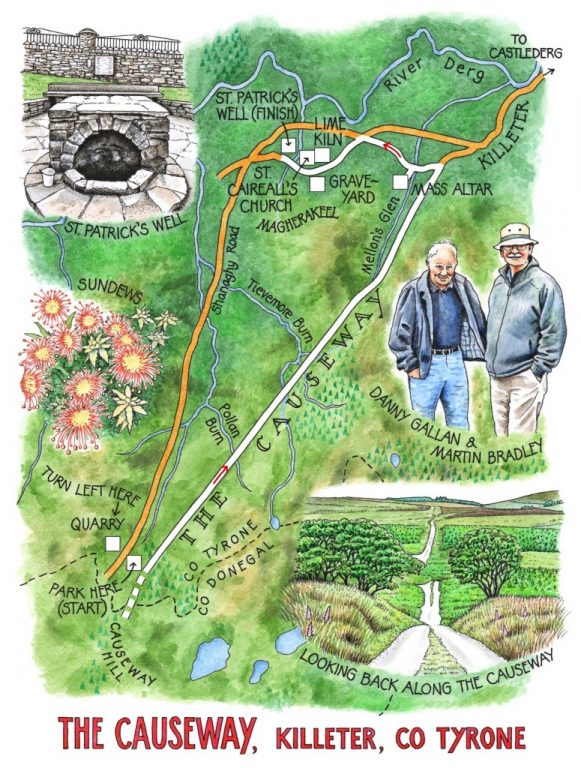
If you’re going to walk way out in the moorlands, and especially in the real high back country of West Tyrone, then you can’t do better than have Martin Bradley at your side. Martin is Tyrone’s countryside officer, so bog myrtle and sphagnum moss, traditional sheep farming practices and the run of field boundaries are just naturally meat and drink to him.
Up on the border between Tyrone and Donegal we parked the car and set out – not down a winding sheep track or a gravelled bog road, but along what must once have been a great and important highway. There’s no mistaking The Causeway in this gently rolling landscape. The broad strip of the upland thoroughfare runs as straight as a die, heading roughly north-east and south-west, unrolling into hollows and up over the back of the moors. Bootprints and sheep slots indent it; fleets of rainwater glint in its furrows, brilliant green and scarlet patches of sodden sphagnum make splash-traps for unwary walkers. You can’t mistake it, and if you have even a squirt of rambling blood in your veins, you can’t resist its summons.
‘I was looking at an old map,’ said Martin as we put our backs to the wind and a spat of rain, ‘and I noticed a dotted line running straight across the moors. The name “Causeway Hill” just off the line seemed to be a good clue, and talking to locals I found out that they’d always known of it.’
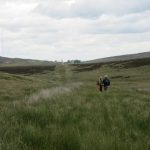
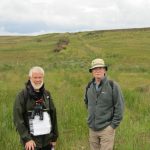
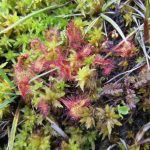
Big views unfurled as we walked the hilly country of West Tyrone; the shark tooth of Errigal away in the north-west, far glimpses of the Sperrin Hills in the east, and behind us the old road rising arrow-straight through the Black Gap towards the empty lands of south Donegal where Lough Derg and the great inland sea of Lower Lough Erne lay hidden by the swell of the land. Could The Causeway have been trodden out as a route to those loughs, for pilgrimage or trade purposes? ‘Well,’ Martin said, ‘I think it could be two thousand years old at least, maybe older. There might be a wooden log trackway under what we see today; excavation would tell us that. But it’s certainly not a famine road. An Iron Age date seems a possibility.’
The bog each side is busy reclaiming The Causeway, enfolding it in a solid blanket of grassy peat. Below that covering, though, the whole trackway is ditched, embanked and provided with neat stone culverts – evidence that it has been used, and highly valued, for a very long time. During the Second World War, Martin told us, The Causeway was a well-trodden smuggling route, bringing milk and meat on the hoof from Donegal into a ration-hit Tyrone.
These boglands are threaded by the Pollan Burn and watered by more than enough rainfall. Plants that love wet and acid conditions grow in abundance: insect-devouring sundews, heath bedstraw, bell heather and bright pink bogbean. Pipits and wheatears flit away, skylarks fill the air with unceasing song. It’s hard to imagine a more beautiful setting for an upland walk – and if you don’t care for the sight of wind-farms, you’d better set out soon.
Down in the valley we turned along the road through the townland of Magherakeel. An ancient church, perhaps 6th-century in foundation, beside an old white-washed school cabin; a graveyard full of angel-carved headstones; a holy well where St Patrick once stopped for a drink and a bit of a sit-down. Danny Gallan of Killeter Historical Society met us at the well, having turned out on this rainy afternoon to unravel the story of it all.
An ancient trackway over a hill, a fund of history and legend along a country lane. Probably every square mile of rural Ireland holds as much, if only we knew where to look, and who to help us seek it.
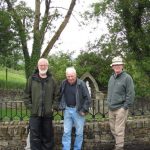
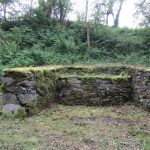
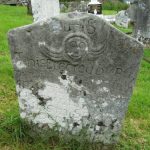
WAY TO GO
Map: OS of Ireland 1:50,000 Discovery Sheet 12.
TRAVEL: (2 cars): From Castlederg (B72 or B50) follow Killeter signs. From Killeter, follow ‘St Patrick’s Well, St Caireall’s Church’.
Leave one car opposite holy well; continue in other car to T-junction; left on Shanaghy road for 3 miles (5 km). Opposite small quarry with double gates on right, turn left along rough track (‘Causeway Walk’). In 150 m park on bend by barrier (‘Causeway Hill’ waymark).
WALK DIRECTIONS: Yellow arrow points right, but you go left past barrier. Follow The Causeway for 3¾ miles (6 km). At foot of lane (yellow arrow), left along country road. At ‘Mellon’s Glen’ signboard, detour left through gate. In 50 m, right at cross-inscribed stone to Mass altar. Return and continue along road. At T-junction, left and left again up Magherakeel Road. Pass lime kiln and St Caireall’s Church to return to St Patrick’s Well.
LENGTH: 5 miles/8 km: allow 2½ – 3 hours
GRADE: Easy
CONDITIONS: Very boggy underfoot in places. Boots, gaiters, waterproof trousers advised.
DON’T MISS:
• Bog flowers
• Views of Blue Stack Mts and Mt Errigal
• Mass altar in Mellon’s Glen.
REFRESHMENTS: Picnic
ACCOMMODATION: Marian McHugh, Glen House, 30 Aghalunny Rd, Killeter BT81 7EZ (028-8167-1983) – offers drop-off and pick-up at start and finish of walk.
GUIDED WALKS: Martin Bradley (028-7131-8473; 079-2678-5706, Martin 839@btinternet.com)
INFORMATION: Walking tour operators, local walks including Discover Ireland’s National Loop Walks and Northern Ireland’s Quality Walks, walking festivals throughout Ireland: www.walkni.com; www.discoverireland.ie/walking
Tourist Information Centre: Strabane (028-718-84444);
www.discovernorthernireland.com
National Trails Day, 2 October: Walks, trails, fun events across Ireland (nationaltrailsday.ie)
BOOK: Christopher’s book Walking in Ireland (Ebury Press) contains 50 of his favourite Irish Independent walks.
csomerville@independent.ie